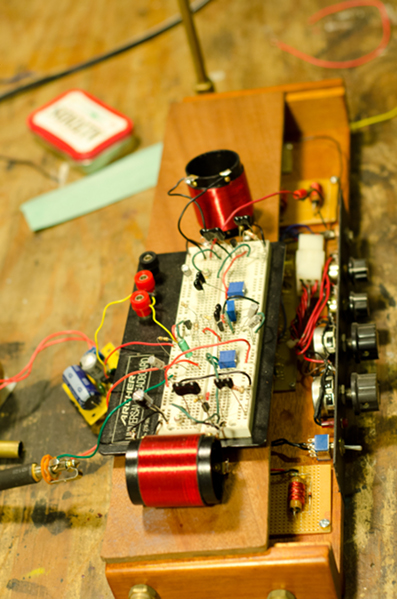"..I'd be interested in seeing some ideas for a transistorized lev oscillator/RCA volume circuits, if any of you talented engineers- so handy w/ the circuit sketch software, feel inclined." - Chobbs
I am not going to contribute any schematics on this subject - I only post stuff I am reasonably certain off, from expierience with actual circuits (except for theoretical explorations, like the Lev oscillator), and I dont have much expierience with VFO based volume circuits.
The only VFO based volume circuits I do have reasonable expierience with is the EPE-2008 theremin, and this works quite well. See: EPE2008_ANOT2.PDF which is the schematic I have annotated with component references.
I would suggest simply replacing the volume oscillator (C20,T3,C21,R25,Q5,VR!,R26,C23) with a Lev oscillator, and putting a capacitor across T4 (pins 1 to 3) to lower the resonant frequency of this filter.
Some means of tuning the Lev oscillator is required if the EPE-2008 volume adjustment scheme is to be duplicated - But I would advise against duplicating it, and instead adding a antenna equalising resonant circuit and tuning this.. Or having no user adjustment of the oscillator frequency, and instead messing about with the gain and/or biasing of the DC amplifier and level shifting op-amp..
As long as the voltage at TP 3 varies proportional to hand position in every environment, one can amplify and shift this voltage to produce a current which controls the volume.. By increasing/decreasing the gain and shifting the offset, one can make the response as snappy or gentle as one wants (well - not true.. You can change the distance over which hand movement affects the volume {gain}, and the position at which it nulls {offset/bias} but you cannot alter the law/linearity)
I suppose what I think may be worth extracting from the EPE-2008 is the simple filter composed of T4, Q6,R30,C25,R29,C24,R27,R28 and C22.. I used an 42IF106 IF transformer with external capacitor across pins 1-3 for T4, and the following circuits (particularly the opto-coupled VCA) work well.. I think it should be possible to implement electronic tuning on the LEV oscillator by biasing the Fet in a similar way to how the EPE oscillator is tuned (perhaps placing a variable resistor on the fets Source rather than to its Drain, and therebye changing its biasing and concequentially its gate capacitance) but I am extremely cautious about such methods, as they tend to have problems with thermal drift etc, unless the design is implemented by someone who completely understands the circuit - I personally dont think I understand the Lev oscillator well enough, and am not great on fets, so cannot advise.
If winding your own coils for the Lev oscillator, adding an extra winding would allow the EPE design to be duplicated more simply, as this could feed Q6 directly as pin 6 of T3 does.. anly a few turns are required (about 20 to 50uH)
Fred.



